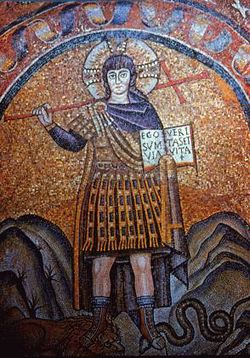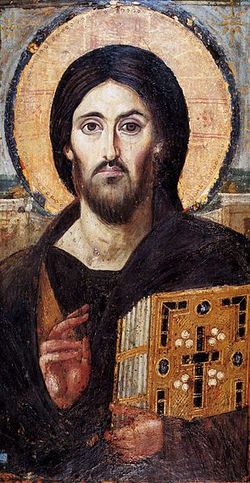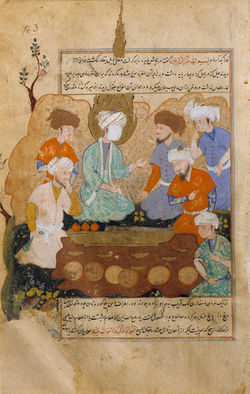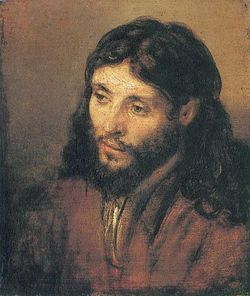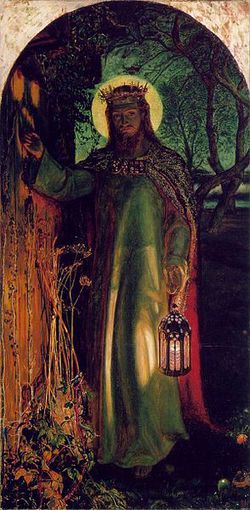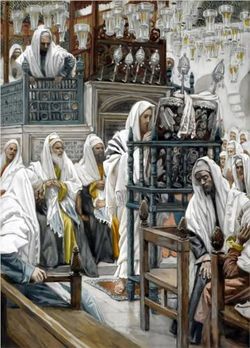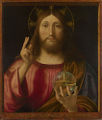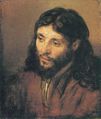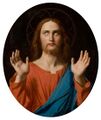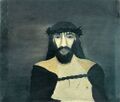Difference between revisions of "Category:Jesus of Nazareth (subject)"
| (100 intermediate revisions by the same user not shown) | |||
| Line 1: | Line 1: | ||
*[[:Category:People|BACK | [[File:Christ Ravenna.jpg|thumb|250px|Portrait of Jesus (Ravenna, 6th cent.)]] | ||
[[File:Christ 6cent.jpg|thumb|250px|Portrait of Jesus (Sinai, 6th cent.)]] | |||
[[File:Isa Islam.jpg|thumb|250px|Isa (Jesus) bringing down heavenly food for his disciples (Quran 5:111-115 [cf. John, ch. 6])]] | |||
[[File:Christ Rembrandt.jpg|thumb|250px|[[Portrait of Christ's Head (1650 Rembrandt), art]]]] | |||
[[File:Jesus Hunt.jpg|thumb|250px|[[The Light of the World (1854 Hunt), art]]]] | |||
[[File:Jesus Synagogue Tissot.jpg|thumb|250px|Yeshua (Jesus) preaching at the synagogue]] | |||
[[File:Henderson-Bland Jesus Olcott.jpg|thumb|250px|Robert Henderson-Bland as ''Jesus'' in [[From the Manger to the Cross (1912 Olcott), film]]]] | |||
[[File:Crucifixion White Chagall.jpg|thumb|250px|A Jewish representation of Yoshua (Jesus) by Marc Chagall (1939)]] | |||
[[File:Irazoqui Jesus Pasolini.jpg|thumb|250px|Enrique Irazoqui as ''Jesus'' in [[Il vangelo secondo Matteo (1964 Pasolini), film]]]] | |||
[[File:Neeley Jesus Superstar.jpg|thumb|250px|Ted Neeley as Jesus in [[Jesus Christ Superstar (1973 Jewison), film]]]] | |||
[[File:Jesus Godspell.jpg|thumb|250px|Victor Garber as Jesus in [[Godspell (1973 Greene), film]]]] | |||
[[File:Kosi SonMan.jpg|thumb|250px|Andile Kosi as Jesus in [[The Son of Man (2005 Dornford-May), film]]]] | |||
[[File:Nia Jesus Talebzadeh.jpg|thumb|250px|Ahmad Soleimani Nia as Jesus in [[Mesih (2007 Talebzadeh), film]]]] | |||
*[[Historical Jesus Studies|BACK to HISTORICAL JESUS STUDIES]] | |||
*[[:Category:People|BACK to the PEOPLE--INDEX]] | |||
According to Christian (Jewish, and Islamic) traditions, '''Jesus of Nazareth''' (c.5 BCE - c.30 CE) was a Jewish religious leader and [[Messiah Claimants|Messiah claimant]], and the founder of the Christian movement. | According to Christian (Jewish, and Islamic) traditions, '''Jesus of Nazareth''' (c.5 BCE - c.30 CE) was a Jewish religious leader and [[Messiah Claimants|Messiah claimant]], and the founder of the Christian movement. | ||
< [[Jesus of Nazareth (sources)]] -- [[Jesus of Nazareth (fiction)]] -- [[Jesus of Nazareth (scholarship)]] > | |||
*[[Nativity of Jesus]] | *[[Life of Jesus]] | ||
**[[Annunciation to Mary]] / [[Birth of Jesus]] / [[Adoration of the Shepherds]] / [[Circumcision of Jesus]] / [[Presentation of Jesus at the Temple]] / [[Adoration of the Magi]] / [[Massacre of the Innocents]] / [[Flight into Egypt]] | |||
*[[Nativity of Jesus]] (Baby Jesus) | |||
**[[Annunciation to Mary]] / [[Birth of Jesus]] / [[Adoration of the Shepherds]] / [[Circumcision of Jesus]] / [[Presentation of Jesus at the Temple]] / [[Adoration of the Magi]] / [[Massacre of the Innocents]] / [[Flight into Egypt]] | |||
*[[Childhood of Jesus]] (Child Jesus) | |||
**[[Holy Family]] / [[Jesus among the Doctors]] / [[Jesus at Nazareth]] | |||
*[[Jesus' Hidden Years]] (Young Jesus) | |||
**[[Death of Joseph of Nazareth]] | |||
**See also [[Jesus in India]] / [[Jesus at Qumran]] / [[Married Jesus]] | |||
*[[Ministry of Jesus]] | *[[Ministry of Jesus]] | ||
| Line 13: | Line 36: | ||
*[[Passion of Jesus]] | *[[Passion of Jesus]] | ||
**[[Triumphal Entry into Jerusalem]] | **[[Triumphal Entry into Jerusalem]] -- [[Cleansing of the Temple]] -- [[Plot to Kill Jesus]] -- [[Anointing of Jesus]] -- [[Betrayal of Judas]] -- [[Last Supper]] -- [[Agony in the Garden]] -- [[Arrest of Jesus]] -- [[Trial of Jesus before the High Priest]] -- [[Peter's Denial]] -- [[Trial of Jesus before Pilate]] -- [[Trial of Jesus before Herod Antipas]] -- [[Barabbas]] -- [[Flagellation of Jesus]] -- [[Mocking of Jesus]] -- [[Way to Golgotha]] -- [[Crucifixion of Jesus]] -- [[Burial of Jesus]] | ||
*[[Resurrection of Jesus]] | *[[Resurrection of Jesus]] | ||
**[[Risen Christ]] | **[[Risen Christ]] -- [[Appearances of Jesus]] -- [[Ascension of Jesus]] | ||
*[[Relics of Jesus]] | |||
==Overview== | ==Overview== | ||
==In | Jesus was born a Jew in Galilee, most likely during the last years of the kingdom of Herod the Great. We know nothing about his youth until he joined the movement of [[John the Baptist]] in the expectation of the imminent coming of the [[Kingdom of God]]. Back to Galilee, he acquired fame as a miracle-worker and led a reform movement within Judaism that soon became a messianic movement, as Jesus claimed (or was claimed) to the [[Messiah]], the [[Son of Man]]. Jesus preached mostly in small villages around the [[Lake of Galilee]] and avoid the larger (Hellenistic) towns of the region. At the end the confrontation with the authorities of the Jerusalem Temple in occasion of the Passover Feast, led to his execution by the Romans as a troublemaker. | ||
After his death on the cross, his disciples claimed he had been raised by God and was now in Heaven at the right hand of the Father, waiting for the time of his return at the end of times as the final Judge. By the end of the 1st century, Christianity spread far beyond the boundaries of the Jewish people, attracting many Gentile members and Jesus was seen as the divine Son of God, or God incarnated. What was at its inception a Jewish messianic movement gradually became an autonomous religion, which had its center in the faith in Jesus as the universal Savior. | |||
Jesus remained a controversial figure in Judaism, where he came to be seen as a heretic or a failed messiah. While denying his divinity, Islam saw in Jesus a great prophet and messenger of God, who came to completed the Torah and announce the coming of Mohammad as the final prophet. | |||
While Christianity, Judaism and Islam have argued (and often clashed) about the religious interpretation of the figure of Jesus, interest in the "historical" dimension of this figure has arose since the Enlightenment, generating new questions and new interpretations about his life and preaching, both in scholarship and in popular culture, inside and outside religious communities. | |||
==Jesus of Nazareth, in ancient sources== | |||
====Early Jewish Sources: (a) Opinions about Jesus==== | |||
Mark 8:27–30 (NRSV) [see [[Peter's Confession]]] -- 27 Jesus went on with his disciples to the villages of Caesarea Philippi; and on the way he asked his disciples, "Who do people say that I am?" 28 And they answered him, "John the Baptist; and others, Elijah; and still others, one of the prophets." 29 He asked them, "But who do you say that I am?" Peter answered him, "You are the Messiah." 30 And he sternly ordered them not to tell anyone about him. | |||
====Early Jewish Sources: (b) The Testimony of [[Gamaliel]] (according to the [[Acts of Apostles]])==== | |||
Acts 5:34-39 -- '' The high priest rose up, and all they that were with him (which is the sect of the Sadducees), and they were filled with jealousy, and laid hands on the apostles, and put them in public ward…. A Pharisee in the council named Gamaliel, a teacher of the Law, respected by all the people, stood up and… said: Fellow Israelites… some time ago Theudas stood up, claiming to be somebody, and a number of men, about four hundred, joined him; but he was killed, and all who followed him were dispersed and disappeared. After him Judas the Galilean rose up at the time of the census and got people to follow him; he also perished, and all who followed him were scattered. So is the case [of Jesus]'' | |||
Cf. Josephus, Ant 18:3-10, 23 ([[Judas the Galilean]]) -- ''At the time of the census… Judas (with the support of Saddok) threw himself into the cause of rebellion… He urged people that Heaven would be their zealous helper… if with high devotion in their hearts they stood firm and did not shrink from the bloodshed that might be necessary… Judas and Saddok started among us a new school which in all other aspects agrees with the opinion of the Pharisees, except that they have a passion for liberty that is almost unconquerable, since they are convinced that God alone is their leader and master.'' | |||
Cf. Josephus, Ant 20:97-98 ([[Theudas]]) -- ''During the period when [[Fadus]] was procurator of [[Judea]], a certain impostor named [[Theudas]] persuaded the majority of the masses to take up their possessions and to follow him to the [[Jordan River]]. He stated that he was a prophet and that at his command the river would be parted and would provide them an easy passage. With this talk he deceived many. [[Fadus]], however, did not permit them to reap the fruit of their folly, but sent against him a squadron of cavalry. They fell upon them unexpectedly, slew many of them and took many prisoners. [[Theudas]] himself was captured, whereupon they cut off his head and brought it to [[Jerusalem]].'' | |||
Cf. Josephus, Ant 18:85-89 (the [[Samaritan Prophet]]) -- ''A Samaritan rallied the mob, bidding them go in a body with him on Mount Gerizim, which in their belief is the most sacred of mountains. He assured that on their arrival he would show them the sacred vessels which were buried there, where Moses had deposited them. His hearers, viewing this tale as possible, appeared in arms… But before they could ascend, Pilate blocked their projected route up the mountain with a detachment of cavalry and heavy-armed infantry… Some were killed, the other dispersed. Many prisoners were taken, of whom Pilate put to death the principal leaders.'' | |||
Cf. Ant 20:167-172 (the [[Egyptian Prophet]]) -- ''At this time there came to Jerusalem from Egypt a man who declared that he was a prophet and advised the masses of the common people to go out with him to the mountain called the Mount of Olives… For he asserted that he wished to demonstrate from there that at his command Jerusalem’s walls would fall down, through which he promised to provide an entrance into the city. When Felix heard of this, he ordered his soldiers to take up their arms… He fell upon the Egyptian and his followers, slaying four hundred of them and taking two hundred prisoners. The Egyptian himself escaped from the battle and disappeared.'' | |||
Cf. War 6:300-305 ([[Jesus ben Ananias]]) -- ''As he stood in the Temple, he suddenly began to shout: “…A voice against the Jerusalem and the sanctuary…” Day and night he uttered this cry as he went through all the streets. Some of the more prominent citizens [were] very annoyed at these ominous words…The Jewish authorities… took him before the Roman procurator. There, though scourged till his flesh hung in ribbons, he neither begged for mercy nor shed a tear but lowering his voice to the most mournful of tones answered every blow with “Woe to Jerusalem!” When Albinus – for that was the procurator’s name – demanded to know who he was, where he came from and why he uttered such cries, he made no reply whatever to the questions but endlessly repeated his lament over the city, till Albinus decided that he was a madman and released him.'' | |||
====Early Jewish Sources: (c) The Testimony of Josephus (Testimonium Flavianum) (Josephus, Jewish Antiquities)==== | |||
Ant 18:63-64 -- ''About the time (of Pilate) lived Jesus, a wise man [if indeed it be lawful to call him a man]. He was a doer of wonderful things and a teacher of men who delight in accepting the truth. He attracted many Jews and also many from the Greek world. He was called the Christ [He was indeed the Christ]; and when, on the accusation of our leading men. Pilate condemned him to the cross, those who loved him from the first did not cease to do so. [For he appeared to them again alive on the third day, the divine prophets having foretold these and ten thousand other wonderful things about him.] The race of Christians named after him has survived to this day'' | |||
Cf. Ant 20:199-203 -- ''[The High Priest [[Ananias]]] was a bold man in his temper, and very insolent; he was also of the sect of the Sadducees, who were very rigid in judging offenders, above all the rest of the Jews... He assembled the Sanhedrin of judges, and brought before them the brother of Jesus, who was called Christ, whose name was James, and some of his companions; and when he had formed an accusation against them as breakers of the Law, he delivered them to be stoned'' | |||
====Early Jewish Sources: (d) The Testimony of Rabbi Trypho (according to Justin Martyr)==== | |||
Justin, Dialogue with Trypho -- ''Rabbi Trypho said: It would be better for us to have obeyed our teachers who warned us not to listen to you Christians, nor to converse with you on these subjects, for you have blasphemed many times in your attempt to convince us that this crucified man was with Moses and Aaron, and spoke with them in the pillar of the cloud; that he became man, was crucified, and ascended into Heaven, and will return again to this earth, and that should be worshipped.'' | |||
====Early Christian sources==== | |||
* See [[Gospel of Mark]] / [[Gospel of Matthew]] / [[Gospel of Luke]] / [[Gospel of Thomas]] / [[Gospel of John]] | |||
====Classical sources==== | |||
[[Mara bar Serapion]] (after 73 CE) -- ''What advantage did the Athenians gain from putting Socrates to death? Famine and plague came upon them as a judgment for their crime. What advantage did the men of Samos gain from burning Pythagoras? In a moment their land was covered with sand. What advantage did the Jews gain from executing their wise King? It was just after that their Kingdom was abolished. God justly avenged these three wise men: the Athenians died of hunger; the Samians were overwhelmed by the sea; the Jews, ruined and driven from their land, live in complete dispersion. But Socrates did not die for good; he lived on in the teaching of Plato. Pythagoras did not die for good; he lived on in the statue of Hera. Nor did the wise King die for good; He lived on in the teaching which He had given.'' | |||
[[Suetonius]] (ca. 120 CE) -- ''([[Claudius]]) expelled the Jews from Rome, since they were always making disturbances because of the instigator Chrestus (Judaeos impulsore Chresto assidue tumultuantis Roma expulit).'' | |||
[[Tacitus]] -- ''Christus, from whom the name (Chrestians) had its origin, suffered the extreme penalty during the reign of Tiberius at the hands of one of our procurators, Pontius Pilatus, and a most mischievous superstition, thus checked for the moment, again broke out not only in Judaea, the first source of the evil, but even in Rome, where all things hideous and shameful from every part of the world find their center and become popular.'' | |||
[[Lucian of Samosata]] (ca. 125 – ca 185; late second century CE) -- “The Christians, you know, worship a man to this day — the distinguished personage who introduced their novel rites, and was crucified on that account… You see, these misguided creatures start with the general conviction that they are immortal for all time, which explains the contempt of death and voluntary self-devotion which are so common among them; and then it was impressed on them by their original lawgiver that they are all brothers, from the moment that they are converted, and deny the gods of Greece, and worship the crucified sage, and live after his laws” (Lucian, The Passing of Peregrinus 12, 13) | |||
[[Celsus]] (late second century CE) -- ''Jesus was born in a certain Jewish village, of a poor woman of the country, who gained her subsistence by spinning, and who was turned out of doors by her husband, a carpenter by trade, because she was convicted of adultery. [Jesus’ father was a certain soldier named Panthera]. After being driven away by her husband, and wandering about for a time, she disgracefully gave birth to Jesus, an illegitimate child. Jesus, having hired himself out as a servant in Egypt on account of his poverty, and having there acquired some miraculous powers, on which the Egyptians greatly pride themselves, returned to his own country, highly elated on account of them, and by means of these proclaimed himself a god.'' | |||
====Later Christian sources==== | |||
*See [[Gospel of Peter]] / [[Protoevangelium of James]] | |||
====Later Rabbinic sources==== | |||
Tosefta (3rd cent. CE) -- Rabbi Eliazer [end of the first cent. CE] said: Once I was walking on the street of Sepphoris. I chanced upon Jacob of Kefar Sikhnin, and he said a word of minut [=heresy] in the name of Yeshua ben Pantira [=Jesus], and it gave me pleasure. I was arrested on charge of minut [=heresy], for I have transgressed the words of the Torah: Keep your path far from her and do not draw near to the entrance of her house [Prov 5:8] (Tosefta, Hullin 2:24). | |||
Babylonian Talmud, Sanhedrin 43a -- ''On the [eve of the] Sabbath day of the Passover festival Yeshu of Nazareth was hanged. For forty days before execution took place, a herald went forth and cried: “Here is Yeshu of Nazareth, who is going forth to be stoned because he has practiced sorcery and enticed Israel to apostasy. Anyone who can say anything in his favor, let him come forth and plead on his behalf.” But since nothing was brought forth in his favor, he was hanged on the eve of Passover.'' | |||
Toledot Yeshu -- ''At the time of King Jannaeus [around 90 BCE] a great misfortune befell to Israel. A certain disreputable man of the tribe of Judah arose, whose name was Joseph Pandera… He lustfully gazed at Miriam… and betrayed her by pretending that he was her betrothed husband, Yohanan… She submitted only against her will... Yohanan left to Babylon. Miriam gave birth to a son and named him Yehoshua, after her brother… On the eight day he was circumcised… He was instructed in the Jewish tradition… When it was known, that he was the illegitimate son of Joseph Pandera, Yeshu flew to Upper Galilee… Yeshu claimed: “I am the Messiah”… His disciples worshipped him as the Messiah, the Son of the Highest. When word of these things came to Jerusalem, the Sanhedrin decided to arrest Yeshu… with the accusation: “This man is a sorcerer and entices everyone”… Yeshu was arrested and put to death on the sixth hour before the Passover, which that year was also the Sabbath… On the first day of the week his bold followers reported that he was not in his grave; he had ascended to heaven as he had prophesied… '' | |||
====Karaite sources: Yaqub al-Qirqisani (10th cent.)==== | |||
''There is great disagreement over Jesus among the Jews. Some assert he claimed to be a prophet, while others deny it. The Rabbinites [=the Rabbis] deal with this in the Talmud, where they acknowledge that he worked miracles and claim that this was effected by magic and by the Hidden name… Some of the Qaraites say that Jesus was a good man and that his way was the way of Zadok, Anan and others; and that the Rabbinites conspired against him and killed him just as they sought to kill Anan also, but without success. This is their way with all who would oppose them. Jesus forbade divorce, just as the Sadducees forbade it.'' | |||
''The Christian religion as practiced now was invented and proclaimed by Paul: it was he who ascribed divinity to Jesus and claimed to be himself the prophet of Jesus his Lord. He introduced no duties and imposed nothing at all. He asserted that religion is nothing but humility.'' | |||
====Islamic sources==== | |||
*See [[Muslim Jesus]] | |||
[[Category:Index]] | |||
[[Category:Sources]] | |||
==Jesus of Nazareth, in the arts == | |||
* See also [[Jesus in Cinema]] -- [[Jesus in Literature]] -- [[Jesus in Music]] -- [[Jesus in Theatre]] | |||
====Portraits of Jesus==== | |||
<gallery> | |||
File:Christ Ravenna.jpg|Portrait of Jesus (Ravenna, 6th cent.) | |||
File:Christ 6cent.jpg|Portrait of Jesus (Sinai, 6th cent.) | |||
File:Salvator Mundi Antonello.jpg|[[Salvator Mundi (1465 Antonello da Messina), art]] | |||
File:Salvator Mundi Leonardo.jpg|[[Salvator Mundi (1499c Leonardo), art]] | |||
File:Salvator Mundi Previtali.jpg|[[Salvator Mundi (1519 Previtali), art]] | |||
File:Salvator Mundi Carpaccio.jpg|[[Salvator Mundi (1520 Carpaccio), art]] | |||
File:Christ Rembrandt.jpg|[[Portrait of Christ's Head (1650 Rembrandt), art]] | |||
File:Christ Thorvaldsen.jpg|[[Christ (1821 Thorvaldsen), art]] | |||
File:Christ Ingres.jpg|[[Christ (1834 Ingres), art]] | |||
File:Jesus Hunt.jpg|[[The Light of the World (1854 Hunt), art]] | |||
File:Christ Repin.jpg|[[Christ (1884 Repin), art]] | |||
File:Christ Simonet.jpg|[[Head of Christ (1891 Simonet), art]] | |||
File:Christ Alonso.jpg|[[Cristo Redentor de los Andes (1904 Alonso), art]] | |||
File:Christ Sallman.jpg|[[Head of Christ (1924-1940 Sallman), art]] | |||
File:Christ SilvaCosta.jpg|[[Christ the Redeemer (1931 Silva Costa/Landowski), art]] | |||
File:Jesus Smith.jpg|[[Buddy Christ (1999 Smith), art]] | |||
File:Christ Cornish.jpg|[[Jesus Christ (2009 Cornish), art]] | |||
</gallery> | |||
====Jesus, the Suffering Man ("Man of Sorrows," or, ''Ecce Homo'')==== | |||
* See [[Man of Sorrows]]; see also [[Ecce Homo]]. | |||
<gallery> | |||
File:Ecce Homo Antonello.jpg|[[Ecce Homo (1473 Antonello da Messina), art]] | |||
File:Ecce Homo Solari.jpg|[[Ecce Homo (1506 Solari), art]] | |||
File:Ecce Homo Titian.jpg|[[Ecce Homo (1548 Titian), art]] | |||
File:Ecce Homo Bouts.jpg|[[Man of Sorrow (1549 Bouts), art]] | |||
File:Ecce Homo Dolci.jpg|[[Ecce Homo (1635 Dolci), art]] | |||
File:Ecce Homo Reni.jpg|[[Ecce homo (1639 Reni), art]] | |||
File:Ecce Homo Cerezo.jpg|[[Ecce Homo (1650 Cerezo), art]] | |||
File:Christ Thorns Pippin.jpg|[[Christ Crowned With Thorns (1938 Pippin), art]] | |||
File:Black Jesus.jpg|Black Jesus (1960s) | |||
</gallery> | |||
*1971 - E Johnny prese il fucile interpretato da Donald Sutherland >Immagine | |||
*1980 - Il ladrone interpretato da Claudio Cassinelli > Immagine | |||
*1987 - Secondo Ponzio Pilato interpretato da Carlo Panchetti | |||
*1999 - Jesus interpretato da Jeremy Sisto > Immagine | |||
*2000 - Maria,Figlia del suo Figlio interpretato da Nicholas Rogers >Immagine | |||
*2001 - Gli amici di Gesù, interpretato da Danny Quinn | |||
*2001 - Gli amici di Gesù - Giuseppe di Nazareth interpretato da Jurij Gentilini all'età di 11 anni | |||
*2005 - San Pietro interpretato da Johannes Brandrup >Immagine | |||
*2006 - L'inchiesta interpretato da Fabrizio Bucci Immagine | |||
*2012 - Maria di nazareth interpretato da Andreas Pietschmann > Immagine | |||
====Young Jesus==== | |||
* See [[Childhood of Jesus]] | |||
* [[Jesus of Nazareth (arts)]] | * [[Jesus of Nazareth (arts)]] | ||
==Jesus in scholarship== | |||
* [[Jesus of Nazareth (research)]] | * [[Jesus of Nazareth (research)]] | ||
==Related categories== | ==Related categories== | ||
*[[Messiah]] -- [[Messiah Claimants]] | *[[Messiah]] -- [[Messiah Claimants]] -- [[Jewish views of Jesus]] | ||
==References== | ==References== | ||
| Line 43: | Line 205: | ||
[[Category:Index (database)]] | [[Category:Index (database)]] | ||
[[Category:People (database)]] | [[Category:People (database)]] | ||
[[Category:Prophets (subject)]] | |||
Latest revision as of 01:58, 28 May 2019


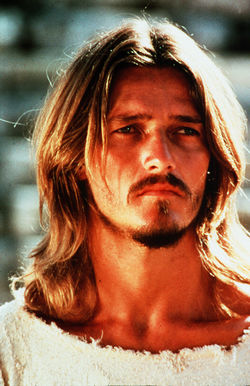


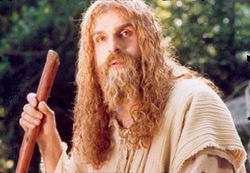
According to Christian (Jewish, and Islamic) traditions, Jesus of Nazareth (c.5 BCE - c.30 CE) was a Jewish religious leader and Messiah claimant, and the founder of the Christian movement.
< Jesus of Nazareth (sources) -- Jesus of Nazareth (fiction) -- Jesus of Nazareth (scholarship) >
- Nativity of Jesus (Baby Jesus)
- Childhood of Jesus (Child Jesus)
- Jesus' Hidden Years (Young Jesus)
- Passion of Jesus
- Triumphal Entry into Jerusalem -- Cleansing of the Temple -- Plot to Kill Jesus -- Anointing of Jesus -- Betrayal of Judas -- Last Supper -- Agony in the Garden -- Arrest of Jesus -- Trial of Jesus before the High Priest -- Peter's Denial -- Trial of Jesus before Pilate -- Trial of Jesus before Herod Antipas -- Barabbas -- Flagellation of Jesus -- Mocking of Jesus -- Way to Golgotha -- Crucifixion of Jesus -- Burial of Jesus
Overview
Jesus was born a Jew in Galilee, most likely during the last years of the kingdom of Herod the Great. We know nothing about his youth until he joined the movement of John the Baptist in the expectation of the imminent coming of the Kingdom of God. Back to Galilee, he acquired fame as a miracle-worker and led a reform movement within Judaism that soon became a messianic movement, as Jesus claimed (or was claimed) to the Messiah, the Son of Man. Jesus preached mostly in small villages around the Lake of Galilee and avoid the larger (Hellenistic) towns of the region. At the end the confrontation with the authorities of the Jerusalem Temple in occasion of the Passover Feast, led to his execution by the Romans as a troublemaker.
After his death on the cross, his disciples claimed he had been raised by God and was now in Heaven at the right hand of the Father, waiting for the time of his return at the end of times as the final Judge. By the end of the 1st century, Christianity spread far beyond the boundaries of the Jewish people, attracting many Gentile members and Jesus was seen as the divine Son of God, or God incarnated. What was at its inception a Jewish messianic movement gradually became an autonomous religion, which had its center in the faith in Jesus as the universal Savior.
Jesus remained a controversial figure in Judaism, where he came to be seen as a heretic or a failed messiah. While denying his divinity, Islam saw in Jesus a great prophet and messenger of God, who came to completed the Torah and announce the coming of Mohammad as the final prophet.
While Christianity, Judaism and Islam have argued (and often clashed) about the religious interpretation of the figure of Jesus, interest in the "historical" dimension of this figure has arose since the Enlightenment, generating new questions and new interpretations about his life and preaching, both in scholarship and in popular culture, inside and outside religious communities.
Jesus of Nazareth, in ancient sources
Early Jewish Sources: (a) Opinions about Jesus
Mark 8:27–30 (NRSV) [see Peter's Confession] -- 27 Jesus went on with his disciples to the villages of Caesarea Philippi; and on the way he asked his disciples, "Who do people say that I am?" 28 And they answered him, "John the Baptist; and others, Elijah; and still others, one of the prophets." 29 He asked them, "But who do you say that I am?" Peter answered him, "You are the Messiah." 30 And he sternly ordered them not to tell anyone about him.
Early Jewish Sources: (b) The Testimony of Gamaliel (according to the Acts of Apostles)
Acts 5:34-39 -- The high priest rose up, and all they that were with him (which is the sect of the Sadducees), and they were filled with jealousy, and laid hands on the apostles, and put them in public ward…. A Pharisee in the council named Gamaliel, a teacher of the Law, respected by all the people, stood up and… said: Fellow Israelites… some time ago Theudas stood up, claiming to be somebody, and a number of men, about four hundred, joined him; but he was killed, and all who followed him were dispersed and disappeared. After him Judas the Galilean rose up at the time of the census and got people to follow him; he also perished, and all who followed him were scattered. So is the case [of Jesus]
Cf. Josephus, Ant 18:3-10, 23 (Judas the Galilean) -- At the time of the census… Judas (with the support of Saddok) threw himself into the cause of rebellion… He urged people that Heaven would be their zealous helper… if with high devotion in their hearts they stood firm and did not shrink from the bloodshed that might be necessary… Judas and Saddok started among us a new school which in all other aspects agrees with the opinion of the Pharisees, except that they have a passion for liberty that is almost unconquerable, since they are convinced that God alone is their leader and master.
Cf. Josephus, Ant 20:97-98 (Theudas) -- During the period when Fadus was procurator of Judea, a certain impostor named Theudas persuaded the majority of the masses to take up their possessions and to follow him to the Jordan River. He stated that he was a prophet and that at his command the river would be parted and would provide them an easy passage. With this talk he deceived many. Fadus, however, did not permit them to reap the fruit of their folly, but sent against him a squadron of cavalry. They fell upon them unexpectedly, slew many of them and took many prisoners. Theudas himself was captured, whereupon they cut off his head and brought it to Jerusalem.
Cf. Josephus, Ant 18:85-89 (the Samaritan Prophet) -- A Samaritan rallied the mob, bidding them go in a body with him on Mount Gerizim, which in their belief is the most sacred of mountains. He assured that on their arrival he would show them the sacred vessels which were buried there, where Moses had deposited them. His hearers, viewing this tale as possible, appeared in arms… But before they could ascend, Pilate blocked their projected route up the mountain with a detachment of cavalry and heavy-armed infantry… Some were killed, the other dispersed. Many prisoners were taken, of whom Pilate put to death the principal leaders.
Cf. Ant 20:167-172 (the Egyptian Prophet) -- At this time there came to Jerusalem from Egypt a man who declared that he was a prophet and advised the masses of the common people to go out with him to the mountain called the Mount of Olives… For he asserted that he wished to demonstrate from there that at his command Jerusalem’s walls would fall down, through which he promised to provide an entrance into the city. When Felix heard of this, he ordered his soldiers to take up their arms… He fell upon the Egyptian and his followers, slaying four hundred of them and taking two hundred prisoners. The Egyptian himself escaped from the battle and disappeared.
Cf. War 6:300-305 (Jesus ben Ananias) -- As he stood in the Temple, he suddenly began to shout: “…A voice against the Jerusalem and the sanctuary…” Day and night he uttered this cry as he went through all the streets. Some of the more prominent citizens [were] very annoyed at these ominous words…The Jewish authorities… took him before the Roman procurator. There, though scourged till his flesh hung in ribbons, he neither begged for mercy nor shed a tear but lowering his voice to the most mournful of tones answered every blow with “Woe to Jerusalem!” When Albinus – for that was the procurator’s name – demanded to know who he was, where he came from and why he uttered such cries, he made no reply whatever to the questions but endlessly repeated his lament over the city, till Albinus decided that he was a madman and released him.
Early Jewish Sources: (c) The Testimony of Josephus (Testimonium Flavianum) (Josephus, Jewish Antiquities)
Ant 18:63-64 -- About the time (of Pilate) lived Jesus, a wise man [if indeed it be lawful to call him a man]. He was a doer of wonderful things and a teacher of men who delight in accepting the truth. He attracted many Jews and also many from the Greek world. He was called the Christ [He was indeed the Christ]; and when, on the accusation of our leading men. Pilate condemned him to the cross, those who loved him from the first did not cease to do so. [For he appeared to them again alive on the third day, the divine prophets having foretold these and ten thousand other wonderful things about him.] The race of Christians named after him has survived to this day
Cf. Ant 20:199-203 -- [The High Priest Ananias] was a bold man in his temper, and very insolent; he was also of the sect of the Sadducees, who were very rigid in judging offenders, above all the rest of the Jews... He assembled the Sanhedrin of judges, and brought before them the brother of Jesus, who was called Christ, whose name was James, and some of his companions; and when he had formed an accusation against them as breakers of the Law, he delivered them to be stoned
Early Jewish Sources: (d) The Testimony of Rabbi Trypho (according to Justin Martyr)
Justin, Dialogue with Trypho -- Rabbi Trypho said: It would be better for us to have obeyed our teachers who warned us not to listen to you Christians, nor to converse with you on these subjects, for you have blasphemed many times in your attempt to convince us that this crucified man was with Moses and Aaron, and spoke with them in the pillar of the cloud; that he became man, was crucified, and ascended into Heaven, and will return again to this earth, and that should be worshipped.
Early Christian sources
Classical sources
Mara bar Serapion (after 73 CE) -- What advantage did the Athenians gain from putting Socrates to death? Famine and plague came upon them as a judgment for their crime. What advantage did the men of Samos gain from burning Pythagoras? In a moment their land was covered with sand. What advantage did the Jews gain from executing their wise King? It was just after that their Kingdom was abolished. God justly avenged these three wise men: the Athenians died of hunger; the Samians were overwhelmed by the sea; the Jews, ruined and driven from their land, live in complete dispersion. But Socrates did not die for good; he lived on in the teaching of Plato. Pythagoras did not die for good; he lived on in the statue of Hera. Nor did the wise King die for good; He lived on in the teaching which He had given.
Suetonius (ca. 120 CE) -- (Claudius) expelled the Jews from Rome, since they were always making disturbances because of the instigator Chrestus (Judaeos impulsore Chresto assidue tumultuantis Roma expulit).
Tacitus -- Christus, from whom the name (Chrestians) had its origin, suffered the extreme penalty during the reign of Tiberius at the hands of one of our procurators, Pontius Pilatus, and a most mischievous superstition, thus checked for the moment, again broke out not only in Judaea, the first source of the evil, but even in Rome, where all things hideous and shameful from every part of the world find their center and become popular.
Lucian of Samosata (ca. 125 – ca 185; late second century CE) -- “The Christians, you know, worship a man to this day — the distinguished personage who introduced their novel rites, and was crucified on that account… You see, these misguided creatures start with the general conviction that they are immortal for all time, which explains the contempt of death and voluntary self-devotion which are so common among them; and then it was impressed on them by their original lawgiver that they are all brothers, from the moment that they are converted, and deny the gods of Greece, and worship the crucified sage, and live after his laws” (Lucian, The Passing of Peregrinus 12, 13)
Celsus (late second century CE) -- Jesus was born in a certain Jewish village, of a poor woman of the country, who gained her subsistence by spinning, and who was turned out of doors by her husband, a carpenter by trade, because she was convicted of adultery. [Jesus’ father was a certain soldier named Panthera]. After being driven away by her husband, and wandering about for a time, she disgracefully gave birth to Jesus, an illegitimate child. Jesus, having hired himself out as a servant in Egypt on account of his poverty, and having there acquired some miraculous powers, on which the Egyptians greatly pride themselves, returned to his own country, highly elated on account of them, and by means of these proclaimed himself a god.
Later Christian sources
Later Rabbinic sources
Tosefta (3rd cent. CE) -- Rabbi Eliazer [end of the first cent. CE] said: Once I was walking on the street of Sepphoris. I chanced upon Jacob of Kefar Sikhnin, and he said a word of minut [=heresy] in the name of Yeshua ben Pantira [=Jesus], and it gave me pleasure. I was arrested on charge of minut [=heresy], for I have transgressed the words of the Torah: Keep your path far from her and do not draw near to the entrance of her house [Prov 5:8] (Tosefta, Hullin 2:24).
Babylonian Talmud, Sanhedrin 43a -- On the [eve of the] Sabbath day of the Passover festival Yeshu of Nazareth was hanged. For forty days before execution took place, a herald went forth and cried: “Here is Yeshu of Nazareth, who is going forth to be stoned because he has practiced sorcery and enticed Israel to apostasy. Anyone who can say anything in his favor, let him come forth and plead on his behalf.” But since nothing was brought forth in his favor, he was hanged on the eve of Passover.
Toledot Yeshu -- At the time of King Jannaeus [around 90 BCE] a great misfortune befell to Israel. A certain disreputable man of the tribe of Judah arose, whose name was Joseph Pandera… He lustfully gazed at Miriam… and betrayed her by pretending that he was her betrothed husband, Yohanan… She submitted only against her will... Yohanan left to Babylon. Miriam gave birth to a son and named him Yehoshua, after her brother… On the eight day he was circumcised… He was instructed in the Jewish tradition… When it was known, that he was the illegitimate son of Joseph Pandera, Yeshu flew to Upper Galilee… Yeshu claimed: “I am the Messiah”… His disciples worshipped him as the Messiah, the Son of the Highest. When word of these things came to Jerusalem, the Sanhedrin decided to arrest Yeshu… with the accusation: “This man is a sorcerer and entices everyone”… Yeshu was arrested and put to death on the sixth hour before the Passover, which that year was also the Sabbath… On the first day of the week his bold followers reported that he was not in his grave; he had ascended to heaven as he had prophesied…
Karaite sources: Yaqub al-Qirqisani (10th cent.)
There is great disagreement over Jesus among the Jews. Some assert he claimed to be a prophet, while others deny it. The Rabbinites [=the Rabbis] deal with this in the Talmud, where they acknowledge that he worked miracles and claim that this was effected by magic and by the Hidden name… Some of the Qaraites say that Jesus was a good man and that his way was the way of Zadok, Anan and others; and that the Rabbinites conspired against him and killed him just as they sought to kill Anan also, but without success. This is their way with all who would oppose them. Jesus forbade divorce, just as the Sadducees forbade it.
The Christian religion as practiced now was invented and proclaimed by Paul: it was he who ascribed divinity to Jesus and claimed to be himself the prophet of Jesus his Lord. He introduced no duties and imposed nothing at all. He asserted that religion is nothing but humility.
Islamic sources
- See Muslim Jesus
Jesus of Nazareth, in the arts
- See also Jesus in Cinema -- Jesus in Literature -- Jesus in Music -- Jesus in Theatre
Portraits of Jesus
Jesus, the Suffering Man ("Man of Sorrows," or, Ecce Homo)
- See Man of Sorrows; see also Ecce Homo.
- 1971 - E Johnny prese il fucile interpretato da Donald Sutherland >Immagine
- 1980 - Il ladrone interpretato da Claudio Cassinelli > Immagine
- 1987 - Secondo Ponzio Pilato interpretato da Carlo Panchetti
- 1999 - Jesus interpretato da Jeremy Sisto > Immagine
- 2000 - Maria,Figlia del suo Figlio interpretato da Nicholas Rogers >Immagine
- 2001 - Gli amici di Gesù, interpretato da Danny Quinn
- 2001 - Gli amici di Gesù - Giuseppe di Nazareth interpretato da Jurij Gentilini all'età di 11 anni
- 2005 - San Pietro interpretato da Johannes Brandrup >Immagine
- 2006 - L'inchiesta interpretato da Fabrizio Bucci Immagine
- 2012 - Maria di nazareth interpretato da Andreas Pietschmann > Immagine
Young Jesus
Jesus in scholarship
Related categories
References
- / [[]] / In: The Anchor Bible Dictionary (1992 Freedman), dictionary,
- Jesus of Nazareth / Ed Parish Sanders / In: The Eerdmans Dictionary of Early Judaism (2010 Collins / Harlow), dictionary, 803-808
External links
Pages in category "Jesus of Nazareth (subject)"
The following 200 pages are in this category, out of 1,066 total.
(previous page) (next page)1
- Scenes from the Life of Jesus (1150 Master of Palermo Palatine Chapel), art
- Scenes from the Lives of Mary and Jesus (1306 Giotto), art
- Maestà & Scenes from the Lives of Mary and Jesus (1311 Duccio), art
- Scenes from the Life of Jesus (1320 Master of Sant'Abbondio), art
- Scenes from the Life of Jesus (1340 Memmi), art
- Scenes from the Life of Jesus / Armadio degli Argenti (1452 Angelico), art
- Vita di Cristo (Life of Christ / 1472 Cornazzano), poetry (Italian)
- Stories from the Life of Mary and Jesus (1515 Boccaccino), art
- Dass Jesus Christus ein geborner Jude sei (That Jesus Christ Was Born a Jew / 1523 Luther), book
- L'umanità di Cristo (The Humanity of Christ / 1535 Aretino), novel
- The Temptation of Our Lord (1538 Bale), play
- Antiquitates Iudaicae (Jewish Antiquities / 1571 Arias Montano), book
- De los nombres de Christo (The Names of Christ / 1583-95 León), book
- Christus patient (Christ's Passion / 1608 Grotius), play
- Compendium historicum eorum quae Muhammedani de Christo et praecipuis aliquot religionis Christianae capitibus tradiderunt (1643 Warner), book
- L'orto di Getsemani glorioso nei sudori di Cristo (1661 Arresti), oratorio
- Licenza di Giesù da Maria (1661 Arresti), oratorio
- Passíusálmar (1666 Hallgrímur Pétursson), poetry
- Mística Ciudad de Dios: Vida de la Virgen Madre de Dios (1670 Maria de Agreda), vision
- La passione di Giesù Christo (1677 Cherici), oratorio
- In circumcisione Domini (1683 Charpentier), oratorio
- La sepoltura di Cristo (1704 Predieri / Mazzoni), oratorio
- Der für die Sünde der Welt gemarterte und sterbende Jesus (The Story of Jesus, Suffering and Dying for the Sins of the World / 1712 Brockes), libretto
- Maria e Giuseppe in traccia di Gesù (1713 Predieri / Mescoli), oratorio
- Cristo nell’orto (Christ in the Garden / 1718 Fux / Pariati), oratorio
- Il re del dolore (1722 Caldara / Pariati), oratorio
- (++) Johannespassion (St. John Passion / 1724 Bach), oratorio
- Morte e sepoltura di Cristo (1724 Caldara / Fozio), oratorio
- Il testamento di nostro Signore Gesù Cristo sul Calvario (1726 Fux / Pariati), oratorio
- (++) Matthäuspassion (St. Matthew Passion / 1727 Bach), oratorio
- Per la festività del santo natale (For the Feast of Christmas / 1727 Costanzi / Metastasio), oratorio
- Per la festività del santo natale (For the Feast of Christmas / 1727 Metastasio), libretto (oratorio)
- La passione di Gesù Cristo (The Passion of Jesus Christ / 1730 Caldara / @1730 Metastasio), oratorio (music), Vienna premiere
- La passione di Gesù Cristo (The Passion of Jesus Christ / 1730 Metastasio), libretto (oratorio)
- Componimento sagro per il SS.mo Natale di N.S. Gesù Cristo (For the Feast of Christmas / 1735 Mazzoni / 1727 Metastasio), oratorio
- Per la festività del santo natale (For the Feast of Christmas / 1737 Gregori / 1727 Metastasio), oratorio
- La passione di Gesù Cristo (The Passion of Jesus Christ / 1737 Sarro / @1730 Metastasio), oratorio (music), Rome premiere
- The True Gospel of Jesus Christ Asserted (1738 Chubb), book
- (++) The Messiah (1742 Haendel / Jennens), oratorio
- Per la festività del SS.mo Natale (For the Feast of Christmas / 1744 Chiarini / 1727 Metastasio), oratorio
- La passione di Nostro Signor Gesù Cristo (1745 Brunassi), play
- La Passione di Nostro Signore Gesù Cristo (1745 Sellitto), oratorio
- Der Messias (The Messiah / 1748-73 Klopstock), poetry
- Der Tod Jesu (The Death of Jesus / 1755 Graun / @1755 Ramler), oratorio
- Der Tod Jesu (The Death of Jesus / 1755 Telemann / @1755 Ramler), oratorio
- La Passione di Nostro Signor Gesù Cristo (1756 Feroci / Metastasio), oratorio
- An Enquiry into the Divine Missions of John the Baptist, and Jesus Christ (1761 Bell), book
- Colección de varias historias (1767-1768 Santos Alonso), novel
- The Messiah (1768 Cameron), novel
- La passione di Gesù Cristo (1773 Myslivecek / Metastasio), oratorio
- Der Tod Jesu (The Death of Jesus / 1776 Kraus / @1755 Ramler), oratorio
- Ausfuhrung des Plans und Zwecks Jesu (1784-1792 Bahrdt), book
- La passione di Gesù Cristo (1789 Andreozzi), oratorio
- La passione di Gesù Cristo (1799 Nicolini), oratorio
- Natürliche Geschichte des grossen Propheten von Nazareth (Natural History of the Great Prophet of Nazareth / 1800-02 Venturini), book
- La resurrezione di Gesù Cristo (1804 Weigl), oratorio
- (+) The Life and Morals of Jesus of Nazareth (1820 Jefferson), book
- Christus (Christ / 1827-28 Neukomm), oratorio
- Christus (Christ / 1827-38 Schneider), oratorio
- Traditions of Palestine (1830 Martineau), novel
- The Book of Mormon (1830 Smith), vision
- Das bittere Leiden unseres Herrn Jesu Christi (1833 Emmerich, Brentano), vision
- Le sette ultime parole di Nostro Signore Gesù Cristo (1838 Mercadante), oratorio
- Jésus-Christ et sa doctrine (1838 Salvador), book
- Vie de Jésus; ou, Examen critique de son histoire (1839-40 Littré) = Das Leben Jesu: kritisch bearbeitet (The Life of Jesus: Critically Examined / 1835-36 Strauss), book (French ed.)
- Julian; or, Scenes in Judea (1841 Ware), novel
- La dernière incarnation (1846 Constant), novel
- Wichtige, historische Enthüllungen über die wirkliche Todesart Jesu (1849 Venturini), arch-fi book
- Geschichte der Juden: 3. Bis zum Untergang des jüdischen Staates (1856 Graetz), book
- El mártir del Gólgota (1863-64 Pérez Escrich), novel
- Vita di Gesù (1863 Renan / De Boni), book (Italian ed.)
- Traditions of Palestine; or, Scenes in the Holy Land in the Days of Christ (1863 Sargent), novel
- La vita di Gesù; o, Esame critico della sua storia = Das Leben Jesu: kritisch bearbeitet (The Life of Jesus: Critically Examined / 1863 @1835 Strauss), book (Italian ed.)
- Errori di Renan nella vita di Gesù (1864 Capecelatro), non-fiction
- Das Leben Jesu (The Life of Jesus / 1864 Schleiermacher), book
- Scenes from the Life of Jesus (1865-1879 Bloch), art
- Jesus der Christ (1865 Dulk), play
- Der Christus des Glaubens und der Jesus der Geschichte (1865 Strauss), book
- Jesus und Hillel (1866 Delitzsch), book
- Yeshu ha-notsri (1866 Goldstein), novel
- Christus (1866 Liszt), oratorio
- La vita di Gesù Cristo (1868 Capecelatro), non-fiction
- Calvary (1868 Osborn), play
- Die Stellung Jesu zu den Parteien seiner Zeit (1868 Sartori), book
- Della vita di Gesù Cristo (1869-93 Fornari), non-fiction
- Der Messias (1869 Gensichen), play
- La Bible dans l'Inde: vie de Iezeus Christna (The Bible in India / 1869 Jacolliot), arch-fi book
- The Divine Tragedy (1871 Longfellow), poem
- Ein Tag in Capernaum (1872 Delitzsch), novel
- The Coming of the Messiah (1873 Winkley), play
- Il Vangelo spiegato, difeso, meditato = L'Évangile expliqué, défendu, médité (The Gospel Explained, Defended, Meditated / 1876-77 @1864-66 Dehaut / Villoresi), book (Italian ed.)
- Christus und die Cäsaren (1877 Bauer), book
- Gesù Cristo: studi storici (Jesus Christ: Historical Studies / 1878 Arosio), book
- Fragments from Reimarus (1879 Reimarus/Lessing), book (English ed.)
- The Life of Jesus Christ (1879 Stalker), book
- La vie de N.-S. Jésus-Christ (1880 Fouard), book
- De prins uit het huis van David (1881 Ingraham), novel (Dutch ed.)
- Des Leben Jesu (1882 Weiss), book
- La vie de N.S. Jésus-Christ (The Life of Christ / 1883 Le Camus), book
- The Life of Jesus (1883-84 Weiss / Hope), book (English ed.)
- L'Evangelo; ossia, Vita di Gesù Cristo narrata dai quattro evangelisti (The Gospel; or, The Life of Jesus Christ Narrated by the Four Evangelists / 1884 Arosio), book
- The Martyr of Golgotha (1886 Pérez Escrich / Godoy), novel (English ed.)
- Cristo alla festa di Purim (Christ at the Feast of Purim / 1887 Bovio), play (Italian)
- Antiqua Mater: A Study of Christian Origins (1887 Johnson), book
- The Life of Christ according to Extra-Canonical Sources (1887 Pick), book
- Jeschua von Nazara (1888 Ador), novel
- Das Selbstbewusstsein Jesu im Lichte der messianischen Hoffnungen seiner Zeit (1888 Baldensperger), book
- Emmanuel (1889 Cooley), novel
- Vita di Gesù (Life of Jesus / 1890 Bonghi), non-fiction
- Jesus of Nazareth (1890 Broadus), book
- The Light of the World; or, The Great Consummation (1891 Arnold), poem
- Jesus, the Carpenter of Nazareth (1891 Bird), juvenile novel
- Der sogenannte historische Jesus und der geschichtliche, biblische Christus (1892 Kähler), book
- Die Predigt Jesu vom Reiche Gottes (Jesus' Proclamation of the Kingdom of God / 1892 Weiss), book
- The Wandering Jew (1893 Buchanan), poem
- The Gospel and Its Earliest Interpretations (1893 Cone), book
- Christ at the Feast of Purim = Cristo alla festa di Purim (1894 @1887 Bovio / Scott-Uda), play (English ed.)
- Jesús de Nazareth (Jesus of Nazareth / 1894 Guimerá), play
- L'Évangile de l'enfance de Notre Seigneur Jésus-Christ selon saint Pierre (1894 Mendès & Schwabe), arch-fi
- The Unknown Life of Jesus Christ (1894 Notovitch), arch-fi (English ed.)
- Life of Jesus (1894 Tissot), art
- As Others Saw Him (1895 Jacobs), novel
- An Introduction to the Life of Jesus: An Investigation of the Historical Sources (1896 Anthony), book
- Jesus of Nazareth (1896 Barlow), play
- The Student's Life of Jesus (1896 Gilbert), book
- John: A Tale of King Messiah (1896 Woods), novel
- The Horitz Passion Play (1897 Freeman), short film
- Passion du Christ (Passion of Christ / 1897 Kirchner), short film
- La vie et la passion de Christ (The Life and Passion of Jesus Christ / 1898 Hatot), short film
- The Passion Play (1898 Lubin), short film
- La risurrezione di Cristo (1898 Perosi), oratorio
- La trasfigurazione di N.S. Gesù Cristo (1898 Perosi), oratorio
- The Passion Play of Oberammergau (1898 Vincent), short film
- La passione di Cristo (The Passion of Christ / 1899 Calcina), short film
- Christus (1899 Draeseke), oratorio
- The Man of Galilee (1899 Haygood), book
- Le Christ marchant sur les eaux (Christ Walking on Water / 1899 Méliès), short film
- Passione di Gesù (Passion of Jesus / 1900 Cristofari, Topi), short film
- La "Vita di Gesù" di Ernesto Renan in Italia: studio critico (1900 Labanca), book
- La vita di N. S. Gesù Cristo = La vie de N.S. Jésus-Christ (The Life of Christ / 1900 @1883 Le Camus / Gramatica), book (Italian ed.)
- L'entrata di Cristo in Gerusalemme (1900 Perosi), oratorio
- The Life of Jesus of Nazareth (1900 Rhees), book
- Tsar’ iz doma Davida (1901 Ingraham), novel (Russian ed.)
- The Teaching of Jesus (1901 Stevens), book
- Rich and Poor in the New Testament (1902 Cone), book
- Jesús Nazareno (Jesus of Nazareth / 1902 García Velloso), play
- Ben Tobit (1903 Andreyev), novel
- The Apostles (1903 Elgar), oratorio
- Under the Stars (1903 Kingsley), novel
- The Passion Play Series (1903 Lubin), feature film
- The Founder of Christendom (1903 Smith), book
- La vie et la passion de Jésus-Christ (The Life and Passion of Jesus Christ / 1903 Zecca, Nonguet), feature film
- Vergilius (1904 Bacheller), novel
- Il Cristo alla festa di Purim (Christ at the Feast of Purim / 1904 Giannetti / Bovio), opera (music & libretto), Rio de Janeiro premiere
- L'apôtre Paul et Jésus-Christ (The Apostle Paul and Jesus Christ / 1904 Goguel), book
- The Life and Morals of Jesus of Nazareth (1904 @1820 Jefferson / Adler), book (reprint)
- O Rabbi da Galiléia (1904 Lacerda), novel
- Kristuslegender (Christ Legends / 1904 Lagerlöf), novel
- Ben ha-Adam (1904 Levertoff), book
- Olivet to Calvary (1904 Maunder / Wensley), cantata
- Jesus: wer er geschichtlich war (1904 Neumann), book
- La figura storica di Gesù (The Historical Figure of Jesus / 1904 Pandozi), book
- Jezus de Nazarener (1904 Verhulst), play
- Die Quellen des Lebens Jesu (1904 Wernle), book
- The Historic Christ (1905 Lacey), non-fiction
- La naissance, la vie et la mort de N.-S. Jésus-Christ (The Birth, the Life and the Death of Christ / 1906 Guy-Blaché), feature film
- Gesù Cristo, il suo tempo e la sua dottrina (1907-1908 Caraccio), book
- Studies in the Inner Life of Jesus (1907 Garvie), book
- Il Nazareno (The Nazarene / 1907 Giannetti / Golisciani), opera (music & libretto), Rio de Janeiro premiere
- Paulus und Jesus (Paul and Jesus / 1907 Jülicher), book
- Il Cristo storico = The Historic Christ (1907 @1905 Lacey), non-fiction (Italian ed.)
- The Life of Christ in Recent Research (1907 Sanday), book
- The Sources of Our Knowledge of the Life of Jesus (1907 Wernle), book (English ed.)
- Masih Hindustan mein (Jesus in India / 1908 Ahmad), arch-fi book
- The Aquarian Gospel of Jesus (1908 Dowling), vision
- The Character of Jesus (1908 Jefferson), non-fiction
- Der Ursprung des Christentums (1908 Kautsky), book
- Christ Legends = Kristuslegender (1908 @1904 Lagerlöf / Howard), novel (English ed.)
- Paralipomena: Remains of Gospels and Sayings of Christ (1908 Pick), book
- The Synoptic Gospels (1909 Montefiore), book
- Bóg Jezus w świetle badań cudzych i własnych (God Jesus / 1909 Niemojewski), book
- Gott Jesus = Bóg Jezus (God Jesus / 1910 @1909 Niemojewski), book (German ed.)
- The House of Chimham (1909 Work), novel
- The Ethics of Jesus (1910 King), book
- Gesù di Nazareth (1910 Labanca), book
- Some Elements in the Religious Teaching of Jesus according to the Synoptic Gospels (1910 Montefiore), book
- (++) The Quest of the Historical Jesus = Von Reimarus zu Wrede (1910 @1906 Schweitzer / Montgomery, Burkitt), book (English ed.)
- Gesù Cristo e i suoi moderni critici (1911 Ballerini), non-fiction
- Jésus de Nazareth (Jesus of Nazareth / 1911 Calmettes), short film
- The Jewish Sources of the Sermon on the Mount (1911 Friedlander), book
- Satana (Satan / 1912 Maggi), feature film
- The Holy City (1912 Arnaud), short film
- The Historicity of Jesus (1912 Case), book
- The Illumination (1912 Gaskill), short film
- Gesú e il mito di Cristo (Jesus and the Christ Myth / 1912 Puglisi), book
- Socialism and the Ethics of Jesus (1912 Vedder), book
- Thus Saith the Lord (1913 Eclair), short film
- Life and Teachings of Jesus according to the Earliest Records (1913 Kent), book
- Le sette parole di N.S. Gesù Cristo sulla croce (1913 Perosi), oratorio
- Agnus Dei (1913 Ryelandt), oratorio
Media in category "Jesus of Nazareth (subject)"
The following 131 files are in this category, out of 131 total.
- 1803 * Beethoven (oratorio).jpg 300 × 425; 9 KB
- 1855 * Ingraham (novel).jpg 339 × 498; 28 KB
- 1874 Wise.jpg 333 × 500; 27 KB
- 1901 * Wrede.jpg 319 × 499; 16 KB
- 1906 * Schweitzer.jpg 265 × 380; 31 KB
- 1906-E * Hastings.jpg 750 × 1,000; 96 KB
- 1912 Olcott (film).jpg 300 × 460; 49 KB
- 1916 Antamoro (film).jpg 1,382 × 1,761; 278 KB
- 1916 Griffith (film).jpg 403 × 599; 80 KB
- 1921 * Papini (novel).jpg 333 × 499; 25 KB
- 1921 Bennet (film).jpg 214 × 317; 16 KB
- 1923 Wiene (film).jpg 300 × 426; 25 KB
- 1927 DeMille (film).jpg 348 × 490; 76 KB
- 1930 Montefiore.jpg 194 × 259; 5 KB
- 1935 Duvivier (film).jpg 183 × 250; 11 KB
- 1936 * Mauriac (novel).jpg 400 × 659; 219 KB
- 1938 Di Matteo.jpg 180 × 236; 9 KB
- 1939 * Asch (novel).jpg 290 × 500; 36 KB
- 1946 * Wagenknecht.jpg 375 × 500; 36 KB
- 1946 * Graves (novel).jpg 328 × 499; 32 KB
- 1947 * Eastman.jpg 300 × 400; 35 KB
- 1948 * Isaac.jpg 314 × 499; 13 KB
- 1949 Beaudine (film).jpg 323 × 482; 38 KB
- 1951 * Brod (novel).jpg 303 × 500; 50 KB
- 1951 Coyle (film series).jpg 214 × 317; 20 KB
- 1952 Morayta (film).jpg 214 × 317; 24 KB
- 1954 Fabbri.jpg 425 × 600; 145 KB
- 1958 Schuster (film).jpg 230 × 345; 36 KB
- 1960 * Michaud.jpg 341 × 499; 12 KB
- 1960-T * Bornkamm en.jpg 354 × 499; 33 KB
- 1961 * Speare (novel).jpg 332 × 499; 41 KB
- 1961 Ray N (film).jpg 327 × 475; 46 KB
- 1961-T * Waltari (novel) en.jpg 353 × 500; 43 KB
- 1964 Pasolini (film).jpg 231 × 325; 16 KB
- 1965 * Parrinder.jpg 326 × 499; 34 KB
- 1965 * Lofts (novel).jpg 324 × 499; 36 KB
- 1965 Stevens (film).jpg 288 × 416; 179 KB
- 1967 * Brandon.jpg 382 × 582; 59 KB
- 1969 Zacarias (film).jpg 214 × 317; 25 KB
- 1970 * Dodd.jpg 150 × 255; 11 KB
- 1971 Regattieri (film).jpg 282 × 400; 25 KB
- 1972 Zacarias (film).jpg 214 × 317; 24 KB
- 1973 * Bowker.jpg 324 × 499; 13 KB
- 1973 * Greene (film).jpg 200 × 303; 22 KB
- 1973 * Jewison (film).jpg 200 × 302; 29 KB
- 1973 * Vermes.jpg 314 × 499; 26 KB
- 1975 Rossellini (film).jpg 166 × 255; 53 KB
- 1976 Campus (film).jpg 280 × 280; 17 KB
- 1977 * Zeffirelli (TV miniseries).jpg 263 × 475; 43 KB
- 1979 * Jones (film).jpg 280 × 411; 46 KB
- 1979 Sykes (film).jpg 277 × 500; 53 KB
- 1980 Cellan-Jones (film).jpg 230 × 345; 29 KB
- 1982 * Baigent (arch-fi).jpg 279 × 445; 24 KB
- 1982 * Cornfeld.jpg 803 × 1,000; 114 KB
- 1984-E * Bammel Moule.jpg 400 × 599; 72 KB
- 1985 * Cragg.jpg 647 × 1,000; 50 KB
- 1985 * Sanders.jpg 316 × 499; 20 KB
- 1986 * Beasley-Murray.jpg 333 × 499; 29 KB
- 1986 Damiani (film).jpg 284 × 398; 33 KB
- 1987 * Horsley.jpg 328 × 500; 25 KB
- 1988 * Fredriksen.jpg 321 × 499; 42 KB
- 1988 * Scorsese (film).png 300 × 459; 57 KB
- 1989 * Arcand (film).jpg 300 × 419; 37 KB
- 1991 * Baigent Leigh (arch-fi).jpg 368 × 499; 31 KB
- 1991-E * Charlesworth.jpg 306 × 445; 22 KB
- 1991 * Meier.jpg 332 × 499; 31 KB
- 1991 * Saramago (novel).jpg 322 × 499; 22 KB
- 1992 * Vidal (novel).jpg 343 × 499; 37 KB
- 1992-E * Green McKnight.jpg 336 × 499; 29 KB
- 1993 * Neusner.jpg 323 × 500; 36 KB
- 1993 Bergh (film).jpg 300 × 420; 20 KB
- 1993 * Funk.jpg 402 × 500; 43 KB
- 1993 * Vermes.jpg 324 × 499; 25 KB
- 1994 * Meier.jpg 330 × 499; 26 KB
- 1996 * Abecassis (novel).jpg 300 × 463; 35 KB
- 1996 Phipps.jpg 315 × 500; 15 KB
- 1997 * Crace (novel).jpg 333 × 499; 22 KB
- 1998 * Cran (doc).jpg 350 × 500; 61 KB
- 1998 D'Alatri (film).jpg 348 × 488; 25 KB
- 1998-T * Theissen en.jpg 353 × 499; 28 KB
- 1999 Young (miniseries).jpg 200 × 279; 12 KB
- 2000 * Chilton.jpg 328 × 500; 57 KB
- 2000 * Van Voorst.jpg 333 × 499; 27 KB
- 2001-E Bockmuehl.jpg 334 × 500; 51 KB
- 2001 * Crossan Reed.jpg 328 × 499; 46 KB
- 2001 * Meier.jpg 340 × 499; 34 KB
- 2003 * Brown (novel).jpg 279 × 498; 39 KB
- 2003 * Dunn.jpg 328 × 499; 24 KB
- 2003-E * Houlden.jpg 400 × 590; 197 KB
- 2004 * Bock.jpg 984 × 1,500; 150 KB
- 2004 * Ehrman.jpg 329 × 499; 36 KB
- 2005 * Ehrman.jpg 893 × 1,360; 193 KB
- 2004 Palumbo (arch-fi).jpg 400 × 599; 46 KB
- 2005 Feather.jpg 332 × 499; 42 KB
- 2006 * Levine.jpg 328 × 499; 30 KB
- 2006 * Bauckham.jpg 338 × 500; 55 KB
- 2006 * Borg.jpg 328 × 499; 47 KB
- 2006 * Dornford-May (film).jpg 300 × 429; 40 KB
- 2006-E * Levine Allison Crossan.jpg 333 × 499; 24 KB
- 2007-T * Ratzinger en.jpg 992 × 1,500; 133 KB
- 2008-E Evans.jpg 708 × 1,000; 116 KB
- 2008 Moore.jpg 316 × 499; 12 KB
- 2009 * Meier.jpg 331 × 499; 29 KB
- 2010 Allison.jpg 333 × 499; 37 KB
- 2010 Barranchina (film).jpg 188 × 259; 10 KB
- 2010 Billups (film).jpg 214 × 317; 12 KB
- 2010-E Burkett.jpg 347 × 499; 30 KB
- 2007 Vidal.jpg 324 × 499; 26 KB
- 2011 Peters.jpg 331 × 499; 37 KB
- 2011-T * Ratzinger.jpg 968 × 1,500; 94 KB
- 2011-E * Holmen Porter.jpg 400 × 604; 29 KB
- 2012 * Ehrman.jpg 326 × 499; 34 KB
- 2012 * Bond.jpg 319 × 499; 34 KB
- 2013 Bauschke.jpg 343 × 500; 17 KB
- 2013-E Green Brown Perrin.jpg 348 × 499; 29 KB
- 2013 Siddiqui.jpg 328 × 500; 24 KB
- 2014 * Ehrman.jpg 332 × 499; 31 KB
- 2014 Saritoprak.jpg 333 × 499; 22 KB
- 2014 Spencer (film).jpg 486 × 720; 94 KB
- 2014-E Bock Charlesworth.jpg 314 × 499; 15 KB
- 2015 Batty (film) 2.jpg 707 × 1,000; 97 KB
- 2015 Batty (film).jpg 230 × 345; 38 KB
- 2015 Menaul (TV miniseries).jpg 214 × 317; 20 KB
- 2015 Parra (film).jpg 200 × 252; 12 KB
- 2016 Reynolds (film).jpg 214 × 317; 22 KB
- 2017 * Akyol.jpg 329 × 499; 39 KB
- 2018 Khorchide Stosch.jpg 305 × 499; 29 KB
- 2019 Khorchide Stosch en.jpg 312 × 499; 33 KB
- 2019 Segovia.jpg 315 × 499; 14 KB
- 2020 Shumack.jpg 319 × 499; 28 KB
- 2020 Vidal.jpg 333 × 499; 28 KB
